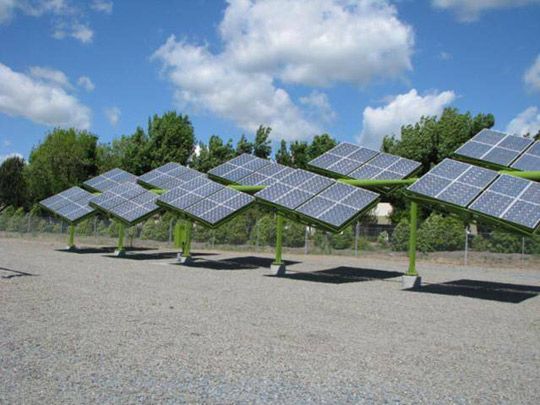GreenVolts, a concentrating photovoltaics (CPV) startup, raised $7.5 million of an anticipated $11.3 million in funding, according to an SEC filing. The firm has raised more than $50 million in venture capital and debt to date from Oak Investment Partners, Greenlight Energy Resources, et al. Here's a link to the Form D filing with the SEC.
The Fremont, California-based company uses low-profile ground-mount equipment to focus sunlight on high-efficiency triple-junction solar cells and at one point was building a 2-megawatt power plant for Pacific Gas & Electric (PG&E) in Tracy, Calif. That project is apparently still active -- despite this photo of the site taken earlier this year by Ed Gunther of the Gunther Portfolio.

Greenvolts recently went through a management shake-up -- the founding CEO, Bob Cart, was replaced by David Gudmundson, formerly of JDSU. Gudmundson has recruited a number of new senior managers into the firm.
-
Where Will DOE’s Loan Program Make the Next Climate Tech Investments?
48
-
What the Frack Is Happening With Natural Gas Prices?
15
-
With an Energy Crisis Brewing, No Peak in Sight for Emissions
9
Many concentrator companies like Greenvolts were formed in the early part of the decade in the midst of a silicon shortage. The shortage ended, Chinese module makers came on the scene to drastically cut the cost of solar, and CPV deals dried up.
But things seem to be picking up. There has been a small surge in CPV news of late:
In the largest CPV deployment to date, Cogentrix Energy announced that it would build a 30-megawatt solar park for a division of Xcel Energy in Colorado. While solar power plants of this scale are common for crystalline silicon or cadmium telluride panels, this is the first CPV deal of its size. The planned facility will use concentrators and trackers from Amonix, which raised $130 million in April from Kleiner Perkins, et al.
Amonix claims its panels are 32 percent efficient and contain cells that are 39 percent efficient. Conventional crystalline silicon cells can convert up to 23 percent of the light that strikes them into power and top out at about 25 percent.
A reliable consultant told us recently that "Amonix is the only company that has more than a few years of on-the-ground performance data. Their product reflects the learned reality that CPV as a utility-scale product shouldn’t try to look, smell or feel like PV (SolFocus) or attempt to minimize installation resources or cost (GreenVolts). They don’t try to hide the cranes and large equipment needed to construct their systems. They also spin/track ten times the kilowatts per unit compared to any of the other CPV competitors."
SolFocus said recently that it would have 10 megawatts in the ground by the end of the year.
Concentrix Solar, German-based CPV vendor, funded by Good Energies and recently purchased by Soitec, just announced the opening of a U.S. office, added more people, and celebrated a CEC listing. More significantly, the firm just announced a 60-kilowatt project in South Africa.
And Solaria -- which specializes in low concentrating technologies -- raised $45 million and hired Dan Shugar as CEO.
Even crystalline silicon champion SunPower is looking at concentrators. CEO Tom Werner told us that the company is looking at concentrators as a way to get around the looming 25 percent wall in crystalline efficiency. Skyline Solar has also made some headway with a concentrator made from comparatively inexpensive sheet metal stamped at a Mexican auto plant.
Cost remains the ruling fact of life in solar, and concentrators do add cost. The technology also only makes sense in particular geographies and circumstances. What's more, banks remain reluctant to fork over cash for projects that rely on untested technologies, with "untested" meaning anything that hasn't been field-tested for a period of 10 to 15 years.
Still, compared to the situation just one year ago, the current moment looks like a world of opportunity for CPV.
New GreenVolts Design:

